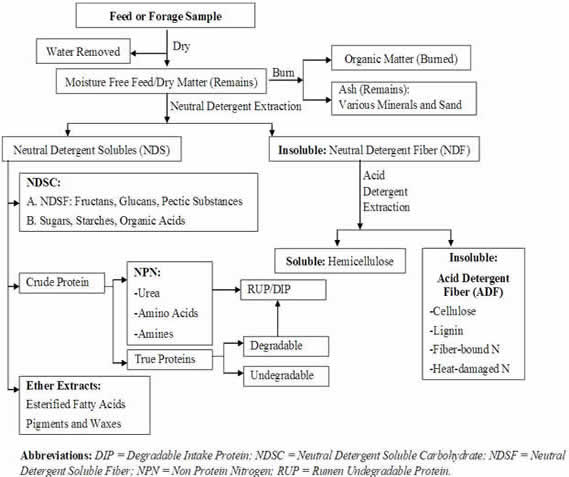Glossary
Introduction to Glossary of Common Terms Used in Animal Feeding and Nutrition
The largest operating cost in a livestock production enterprise is the feed bill. To keep this cost low, one must supply the right amount of feed to the animals. Overfeeding is wasteful. Underfeeding will decrease animal performance and profitability. Proper animal feeding and nutrition are, therefore, crucial to the profitability of the livestock enterprise.
Laboratory analyses of the composition of feed or forage are used to assess their nutritive value of feed. A typical feed analysis includes measurements of some important quality attributes or parameters (e.g., crude protein, fiber, digestibility, etc.) used to define nutritive value. There are some other parameters which are analyzed under some special circumstances. For example, acid detergent insoluble crude protein (ADICP) is usually only measured if heat damage to the feed is suspected.
Figure 1. A schematic that describes the partitioning of organic and mineral components in a feed and forage sample.
Many of the parameters one may encounter on laboratory reports are calculated or estimated from measured feed quality attributes. For example, digestible energy, total digestible nutrients, and intake potential are all estimated from the concentration of the various fiber components and the relationship between them. The University of Georgia’s Feed and Environmental Water Laboratory (FEWL) is located in Athens and dedicated to providing objective analyses of your feeds and forages. This is in line with UGA’s mission as a Land Grant University to provide unbiased interpretations, recommendations, and pertinent educational materials to enhance the profitability and sustainability of livestock production systems in the state.
The purpose of this publication is to serve as an educational reference and resource to those who are interested in animal feeding and nutrition. Our primary objective is to list the common terms used when discussing animal feeding so that one might be better informed when consulting with county extension personnel, feed salesmen, animal nutritionists, veterinarians, feed laboratory managers, and other industry professionals. This listing will also be helpful when reading articles on animal feeding and nutrition, feed analysis reports, or tags associated with the feeds sold in the market.

